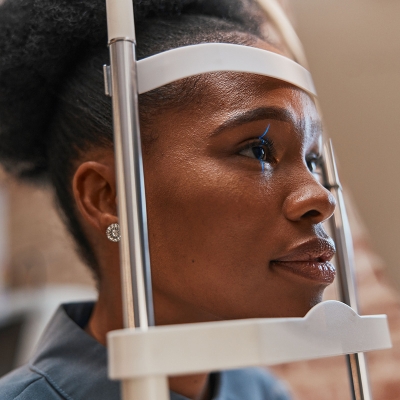The pros and cons of in-network vs. out-of-network eye care providers
Have a vision insurance plan? Here are reasons why a person may want to choose providers that are in-network.

Some people may get their vision insurance through their employer. Others may buy it on the federal Health Insurance Marketplace or from a private insurance company, like UnitedHealthcare Vision.
There can be some great benefits of having a vision insurance plan. For example, a person is typically fully covered for certain preventive care services, like regular eye exams and basic screening tests. They also may get a yearly allowance for glasses or contact lenses.
But if patients are looking to use their vision insurance to see an eye care provider, it may be important for them to know the difference between in-network and out-of-network providers. Here are some potential reasons why.
Eye care providers in the UnitedHealthcare Vision Network are here to help keep your vision healthy. Search for a provider now.
What is an insurance network?
An insurance network is any facility, provider or supplier a person’s insurance company has a contract with to provide certain health services.1
If a person has UnitedHealthcare Vision insurance, they can search online for certain providers and services. These would be considered “in-network.” These eye care providers might be called “in-network providers.”2
What’s the difference between in-network and out-of-network providers?
Eye care providers could be optometrists and ophthalmologists. It’s important to understand that not every eye care provider and facility in a person’s state may be in-network for UnitedHealthcare Vision.
Network providers offer benefits or services to people at a price that the provider and the plan agreed on. Generally, this means that they provide a covered benefit at a lower cost to the plan and the people who have it.2
The eye care providers that aren’t in an insurer’s network may be called “out-of-network providers.” Out-of-network providers and services can cost patients more to use.
What might be some pros to using in-network providers?
There may be advantages to using in-network eye care providers. Here are some potential reasons to do so, if a person has a UnitedHealthcare Vision plan:
- Access. A large network of eye care providers, like UnitedHealthcare Vision Network, can give patients a wider range of options. For example, UnitedHealthcare Vision Network has more than 175,000 provider access points. That can make it easier for a person to use their vision benefits at local doctors, well-known retailers or specialty online retailers.
If a person is on the lookout for a new eye care provider, they can search the provider directory at myuhcvision.com. For each eye care provider, they’ll find a location, contact information, details on credentials and more.
- Familiarity. In-network providers can be more familiar with UnitedHealthcare Vision benefits. That might make a person’s process of getting glasses or contact lenses smoother and more efficient.
- Savings. A big selling point for using in-network providers and services may be the cost savings. For example, if a person gets their glasses or contact lens prescription through an in-network provider, that can save them money. They might also get additional savings through their vision plan on:
- Extra pairs of glasses
- Contact lenses
- Lens upgrades
A person’s plan may also provide an allowance for select glasses and/or contact lens brands, further reducing costs.
- Discounts. A patient may also get discounts on certain vision services. For example, one discount can be for LASIK surgery. (That may also be called laser vision correction.)
LASIK uses a laser to reshape a person’s cornea (the clear round dome at the front of the eye). An ophthalmologist is a type of eye care provider who may perform the surgery. Vision insurance typically doesn’t cover LASIK, so it can get expensive.
While UnitedHealthcare Vision doesn’t cover LASIK, its members can receive some discounts. They can schedule a free exam — and save between 20% and 35% on the cost of surgery through Qualsight LASIK. - Easier claims process. If a person uses an in-network provider, they may also cut down on the amount of paperwork they need to process a vision insurance claim. They may be able to directly bill their insurer for covered services.
What might be the cons of using in-network eye care providers?
While the network may be large, it could have limited choices for some people. Depending on where a person lives, the nearest in-network provider might be far away, making it less convenient. It’s important to check things like this before buying or renewing a plan.
What might be the pros of using out-of-network eye care providers?
A person may decide to see an out-of-network eye care provider because it may be their only option in the area. They may also have switched insurers recently and want to continue seeing an eye care provider, even though that provider may no longer be in their network.
This flexibility can allow a patient to choose an eye care provider based on personal recommendations or specific expertise, even if they’re out-of-network.
What might be the cons of using out-of-network eye care providers?
Some of the biggest drawbacks of using out-of-network eye care providers can be:
- It may cost a person more to see out-of-network eye care providers.
- Out-of-network eye care providers may not offer the same range of benefits as in-network ones do, such as lens upgrades and access to designer frames or contact lens brands.
- The billing process may be more complicated with out-of-network providers, because they may not be familiar with the insurer’s benefits and processes.
Looking for a new eye care provider? Search the UnitedHealthcare Vision Network for an in-network option now.
Sources:
- Network HealthCare.gov.
- What You Should Know about Provider Networks Centers for Medicare & Medicaid Services, February 2024.


